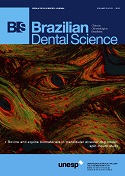The effect of shade and curing mode on cure efficiency of dual-cure resin cements
DOI:
https://doi.org/10.14295/bds.2016.v19i3.1265Abstract
Objective: To evaluate the effect of shade and curing mode on cure efficiency of two dual-cure resin cements. Material and Methods: Two shades (A2 and TRANS) of two different dual-cure resin cements (G-CEM, GC Dental and SET PP, SDI) were submitted to different curing modes: light curing through a 2 mm thick ceramic disc (IPS Empress Esthetic, A2, Ivoclar Vivadent) for 20 s (16 J/cm2), 40 s (32 J/cm2) or 80 s (64 J/cm2) performed immediately or with 1 or 5 min of delay. Fourier transform infrared spectroscopy (FT-IR) was used to evaluate the degree of conversion (DC) after 48 h. For the statistical analysis, data were submitted to three-way analysis of variance, followed by Tukey’s test for multiple comparisons (p=0.05). Results: Shade influenced DC (%) for the dual-cure resin cements tested (p=0.00001). TRANS shade showed lower DC (%) for both cements when there was no delay before light-curing (p=0.00001). Curing mode also influenced DC (%) for the dual-cure resin cements tested: radiant exposure greater than 32 J/cm2 and delaying light-curing for 1 to 5 min increased the DC (%) for both dual-cure resin cements evaluated. Conclusions: One min delay prior to light curing improved the cure efficiency and may be a more clinically acceptable approach to increase the degree of conversion of dual-cure resin cements.
Downloads
Downloads
Additional Files
Published
How to Cite
Issue
Section
License
Brazilian Dental Science uses the Creative Commons (CC-BY 4.0) license, thus preserving the integrity of articles in an open access environment. The journal allows the author to retain publishing rights without restrictions.
=================




























